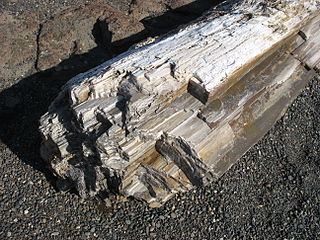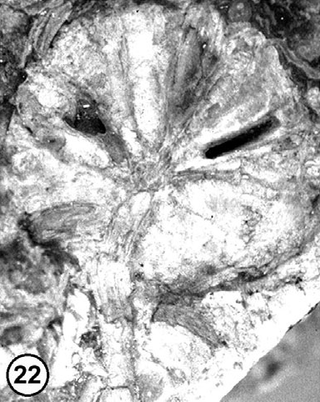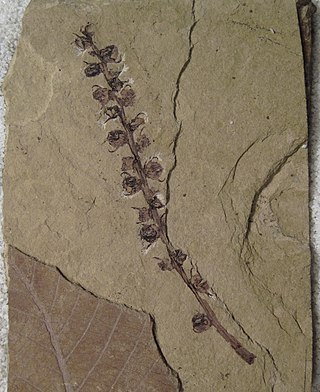
Hickory is a common name for trees composing the genus Carya, which includes 19 species accepted by Plants of the World Online.

Ginkgo Petrified Forest State Park/Wanapum Recreational Area is a geologic preserve and public recreation area covering 7,124-acre (2,883 ha) on the western shoreline of the Columbia River's Wanapum Reservoir at Vantage, Washington. Petrified wood was discovered in the region in the early 1930s, which led to creation of the state park as a national historic preserve. Over 50 species are found petrified at the site, including ginkgo, sweetgum, redwood, Douglas-fir, walnut, spruce, elm, maple, horse chestnut, cottonwood, magnolia, madrone, sassafras, yew, and witch hazel.

Corylus johnsonii is an extinct species of hazel known from fossil fruits found in the Klondike Mountain Formation deposits of northern Washington state, dated to the early Eocene Ypresian stage. Based on described features, C. johnsonii is the oldest definite species in the genus Corylus.

Ginkgo dissecta is an extinct ginkgo species in the family Ginkgoaceae described from a series of isolated fossil leaves. The species is known from Early Eocene sediments exposed in the province of British Columbia, Canada, and Washington, US. It is one of two Ginkgo species found at the Washington and British Columbia sites.

Ginkgo cranei is an extinct Ginkgo species in the family Ginkgoaceae described from a series of isolated fossil ovulate organs and leaves. The species is known from upper Paleocene sediments exposed in the state of North Dakota, US. It is the first Ginkgo species to be described from Paleogene period with reproductive structures.
Cornus piggae is an extinct species of dogwood known from fossil fruits found in Late Paleocene sediments exposed in the US state of North Dakota. C. piggae is one of three extinct species placed in the Cornus subgenus Cornus based on fossil fruit morphology. The other two species, C. ettingshausenii and C. multilocularis are known from pyritized fruits found in sediments of the London Clay in England. C. piggae is the only North American fruit species yet described and is also the oldest described species in Cornus subgenus Cornus.
Taxus masonii is an extinct species of conifer in the yew family, Taxaceae, solely known from the middle Eocene sediments exposed in north central Oregon. The species was first described from a series of isolated fossil seeds in chert.
Torreya clarnensis is an extinct species of conifer in the yew family Taxaceae solely known from the middle Eocene sediments exposed in north central Oregon. The species was first described from a series of isolated fossil seeds in chert.
Diploporus is an extinct genus of conifers in the yew family Taxaceae, containing the single species Diploporus torreyoides known from the middle Eocene of north central Oregon and the Late Paleocene of south central North Dakota. The species was first described from a series of isolated fossil seeds in chert.
Actinidia oregonensis is an extinct species of flowering plants in the kiwifruit family, Actinidiaceae, solely known from the middle Eocene sediments exposed in north-central Oregon. The species was first described from a series of isolated fossil seeds in chert.
Rhus rooseae is an extinct species of flowering plants in the sumac family, Anacardiaceae, solely known from the middle Eocene sediments exposed in north central Oregon. The species was first described from a series of isolated fossil seeds in chert.

Coryloides is an extinct genus of flowering plants in the hazelnut family, Betulaceae, containing the single species Coryloides hancockii. The species is solely known from the middle Eocene sediments exposed in north central Oregon and was first described from a series of isolated fossil nuts in cherts.
Kardiasperma is an extinct genus of flowering plants in the hazelnut family, Betulaceae, containing the single species Kardiasperma parvum. The species is solely known from the middle Eocene sediments exposed in north central Oregon and was first described from a series of isolated fossil nuts in cherts.
Cornus clarnensis is an extinct species of flowering plant in the dogwood family, Cornaceae, solely known from the middle Eocene sediments exposed in north central Oregon. The species was first described from a series of isolated fossil seeds in chert.

Liquidambar changii is an extinct species of sweetgum in the Altingiaceae genus Liquidambar. Liquidambar changii is known from Middle Miocene fossils found in Central Washington.

Quercus hiholensis is an extinct species of oak in the Fagaceae genus Quercus. The species is known from Middle Miocene fossils found in Central Washington.

Shirleya is an extinct genus in the crape myrtle family, Lythraceae, which contains a single species, Shirleya grahamae. The genus and species are known from Middle Miocene fossils found in Central Washington.
Acer beckianum is an extinct maple species in the family Sapindaceae described from a single fossil wood section. The species is solely known from the Middle Miocene sediments exposed in central Washington in the United States. It is one of three Washington state Acer species described in 1961 from petrified wood.

Pentacentron is an extinct genus of flowering plant in the family Trochodendraceae, consisting of the single species Pentacentron sternhartae. The genus is known from fossil fruits found in the early Eocene deposits of northern Washington state, United States. P. sternhartae are possibly the fruits belonging to the extinct trochodendraceous leaves Tetracentron hopkinsii.

Pteronepelys, sometimes known as the winged stranger, is an extinct genus of flowering plant of uncertain affinities, which contains the one species, Pteronepelys wehrii. It is known from isolated fossil seeds found in middle Eocene sediments exposed in north central Oregon and Ypresian-age fossils found in Washington, US.










